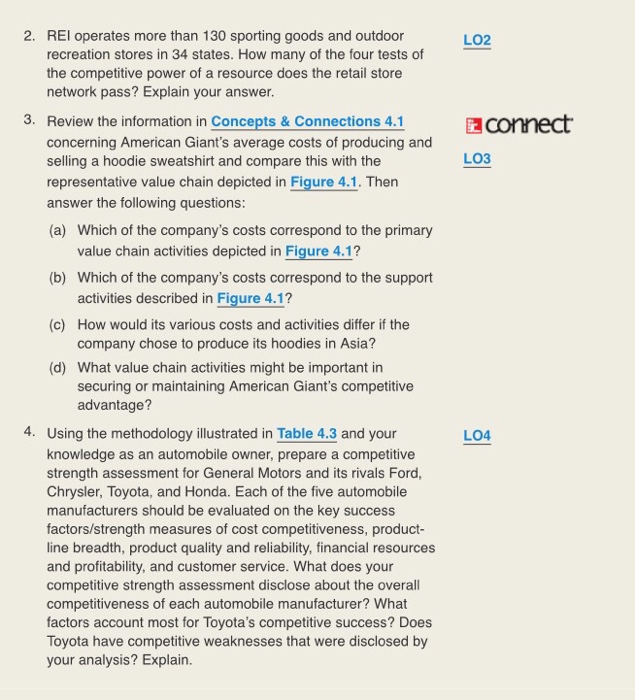Solutions for this

REI operates more than 130 sporting goods and outdoor recreation stores in 34 states. How many of the four tests of the competitive power of a resource does the retail store network pass? Explain your answer. Review the information in Concepts & Connections 4.1 concerning American Giant's average costs of producing and selling a hoodie sweatshirt and compare this with the representative value chain depicted in Figure 4.1. Then answer the following questions: (a) Which of the company's costs correspond to the primary value chain activities depicted in Figure 4.1? (b) Which of the company's costs correspond to the support activities described in Figure 4.1? (c) How would its various costs and activities differ if the company chose to produce its hoodies in Asia? (d) What value chain activities might be important in securing or maintaining American Giant's competitive advantage? Using the methodology illustrated in Table 4.3 and your knowledge as an automobile owner, prepare a competitive strength assessment for General Motors and its rivals Ford, Chrysler, Toyota, and Honda. Each of the five automobile manufacturers should be evaluated on the key success factors/strength measures of cost competitiveness, product-line breadth, product quality and reliability, financial resources and profitability, and customer service. What does your competitive strength assessment disclose about the overall competitiveness of each automobile manufacturer? What factors account most for Toyota's competitive success? Does Toyota have competitive weaknesses that were disclosed by your analysis? Explain. REI operates more than 130 sporting goods and outdoor recreation stores in 34 states. How many of the four tests of the competitive power of a resource does the retail store network pass? Explain your answer. Review the information in Concepts & Connections 4.1 concerning American Giant's average costs of producing and selling a hoodie sweatshirt and compare this with the representative value chain depicted in Figure 4.1. Then answer the following questions: (a) Which of the company's costs correspond to the primary value chain activities depicted in Figure 4.1? (b) Which of the company's costs correspond to the support activities described in Figure 4.1? (c) How would its various costs and activities differ if the company chose to produce its hoodies in Asia? (d) What value chain activities might be important in securing or maintaining American Giant's competitive advantage? Using the methodology illustrated in Table 4.3 and your knowledge as an automobile owner, prepare a competitive strength assessment for General Motors and its rivals Ford, Chrysler, Toyota, and Honda. Each of the five automobile manufacturers should be evaluated on the key success factors/strength measures of cost competitiveness, product-line breadth, product quality and reliability, financial resources and profitability, and customer service. What does your competitive strength assessment disclose about the overall competitiveness of each automobile manufacturer? What factors account most for Toyota's competitive success? Does Toyota have competitive weaknesses that were disclosed by your analysis? Explain








